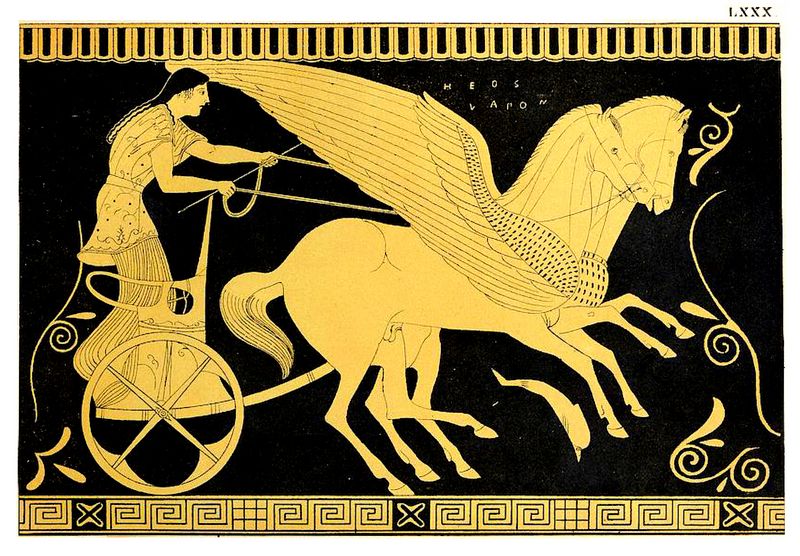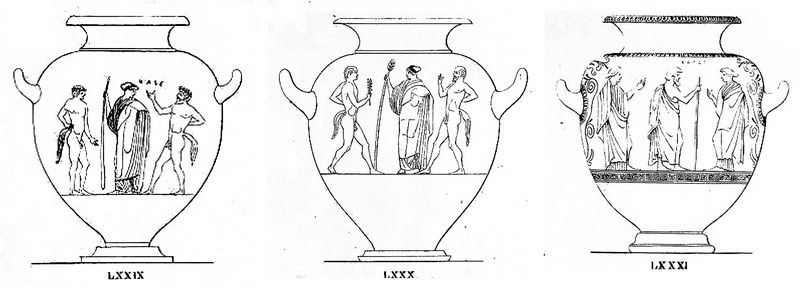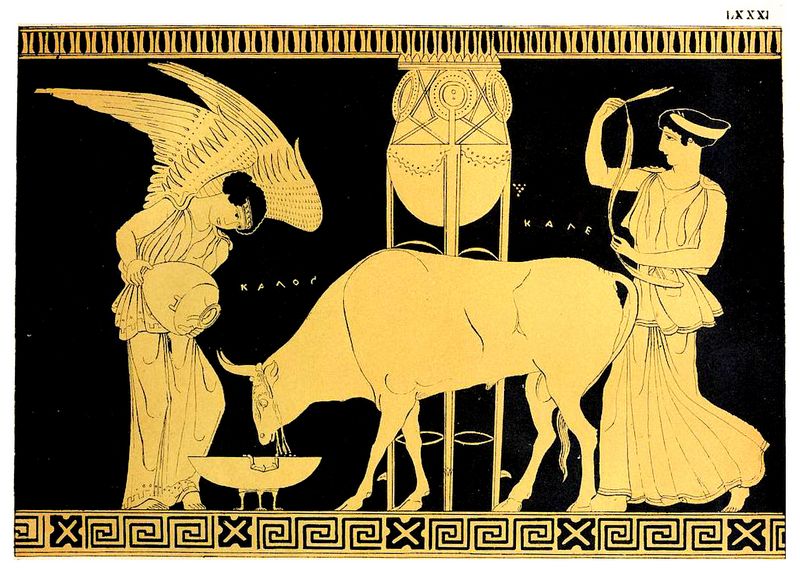|
Selected Greek Vase Paintings, featuring Etruscan examples.
Vol. 2: Heroic Images.
(Published in 1843 as the second part of a 4-volume set, printed by G. Reimer in Berlin).
The introduction of wings in Greek vase paintings; wing shapes.
Plates LXXIX — LXXXIIl.
Between
the gods and the heroes, the imagination of educated Greece assigned
the demons their own place (1). All beings connecting man with the
highest power of the gods are included in this expression; they form a
host of ministering gods who, as outpourings of the divine power of the
Olympian gods, execute commands on earth (2) and sea, mountain and
forest. According to this concept, towns and houses are peopled with
tritons and nereids, pans and nymphs, and in the course of time also
with the eros figures, which some Roman as well as some modern usage
equates with the Italian genii.
The ancient Greek picture
gallery of our vases knew little of thatin relation to the serving
crowd of gods. At the sight of those old Attic works of art, richly
illustrated in the paintings of Etruscan origin, we cannot fail to
notice how precisely the expansion of Greek demonology is connected
with the progress of the plastic arts. A very important accessory to
the separation of those intermediate beings ruling between gods and
men, the wondrous connection of wings with the human form, found its
recognition only at a relatively late period (3).
Wings are
alien to the gods of Homer; In the first upsurge of Greek art at the
time of the tyrants, it was carried over from influences from the
Orient in many ways (p. 2) into Greek art, and incomparably more into
Etruscan works of art; but much was lacking in order to be able to
retain that strange form of culture in Greek art. Such a supernatural
addition made it all too difficult for human culture, which aspired to
nature and beauty, to combine it. Victory horses might have wings
earlier than it was considered permissible to form the messengers and
messengeresses of the gods with artificial wings; so was there less
reason to replace the gods, whom people loved to show in their own
majesty, by servant beings, whose valid expression art had not yet
found.
No matter how extensive the later sculpture was in the
erotic circle of winged boys, how exemplary were the Mysteries of Great
Greece, or how well known the broad wings of the goddess of victory may
be, the artistic evidence of our vase pictures confirms an otherwise
well-founded view, according to which the winged figures of both
Eros and Nike, did not appear until around the time of the Persian wars
(4).
This confirmation comes in abundance from the archaic
vase paintings. If in rare cases their circle of pictures lets us see a
winged boy, the meaning of this is not decidedly erotic; it is divided
between the demon of battle and demon of death (5). Instead of the
female winged figure, who, according to our most current idea, crowns
victors and performs sacrifices, Pallas Athene usually rewards the
heroes' struggle, or Artemis lends a hand to the Pythian donation (6);
indeed, where we meet a hurrying winged woman in the realm of that
older art, we are less entitled to mistake her for Nike,
notwithstanding her similar formation, than for the later vanished
goddess Eris (7) or for one of the goddesses of fate (8).

(p.5)
Finally, as sculpture progressed, ostentatiously evoked by
racetracks and theaters, these winged figures became more frequent,
their representation of the gods more permissible, their form and
meaning more understandable. Busy women, winged for infallible worship,
soon rise to become the most popular works of art; this also happened
with so many causes and accessories that their frequent appearance here
and there leaves us in doubt as to their significance.
To
unhesitatingly recognize the goddess of victory in a winged woman only
frees us according to the artistic usage of Roman times; In the age of
Greek art, on the other hand, with whose monuments we are concerned,
freedom was still unaffected, one and the same winged figure appears
through changing accessories and performance, sometimes as a physical
goddess of dawn, sometimes as the mediating messenger of the divine
decree, and sometimes as a goddess of dangerous victory , soon as
enforcers of sacred sacrificial custom, as a stewardess of godly
consecration or as a welcome goddess of youth and peace.
Thus
it happens that on works of art of the best time the same figure may
apply for Eos (9) and Iris (10), for Nike (11) and Telete (12), for
Hebe (13) as well as for Irene (14). Greek observers may not
infrequently have been embarrassed about the correct choice of these
names, and yet it is due to the explanation of art to limit the
interplay of those names as far as possible.
Plate LXXIX. Winged Eos; Stamnos with reddish figures, formerly with the art dealer Basseggio in Rome.

Plate 80: Eos, goddess of Dawn, with winged horses, from Etruscan vase painting.
Plate LXXX.
Eos
with winged horses; similar vessel (stamnos) in Durand's collection (15).
A
divine figure, which has become considerably more alien to the later
conception, occupies the place in earlier Greek art which Homer already
assigned to it among the governing (p. 6) heavenly powers. If in that
later conception the sun god outshines the goddess of Morgeuroth, then
in earlier times this goddess is to be emphasized so diligently in
speech and legend.
Homer is busy at the beginning of each day
mentioning the rosy traces of the Eos (16); Eos and Hemera, the goddess
of the morning light or of the day, have received a web of legends in
precocious sons and darlings (7) that Helios does not deserve in the
same splendor. This advantage, which the goddess of morning and day had
in the poetic conception of Greece over the sun god whom she proclaims,
is even more pronounced in the worship of the gods in Italy (18); so it
is less strange to see that aspiring goddess celebrated in older forms
of art with special emblems of her unstoppable course. We have two vase
pictures that are very similar to one another, in which their course
appear to be lifted by wings.

Fig.1: Vessel forms (stamnos) and reverse images of vessels in plates 79-81
However,
how this arrangement was carried out more according to artistic freedom
than according to an already established art practice is sufficiently
evident from the differently applied wings of the two pictures. On one
of them (plate 79) it is the goddess who, provided with broad shoulder
wings, hastens the course of her steeds; this way of representation,
which is attested from the best of times (19), is accompanied by the
other on the second of our vessels, according to which the wondrous
addition of wings was intended to make the impetuosity of the animals
more vivid (20). On the whole it is to be assumed that any inspiration
in pictures of the older art was rarely denied to the emerging goddess
of light (21); only when the concept and formation (p.7) of the goddess
of victory put every other winged figure in the shade was the goddess
of the morning light also frequently depicted wingless, with or without
wings on her horses (22).
We will now examine both images more
closely. On both we see the prudent leader of the light-bringing
steeds, reins and whip in her hands, standing on a light carriage and
being pulled forward. By ancient inscription, HEOZ ('Hoog), their
meaning is assured on both; The clothing of the goddess with a long
chiton and a short, belted, richly decorated outer garment, the
protruding hem of which indicates the heaviness of the fabric, is also
consistent on both.
Something else is different in the two
paintings, corresponding to the difference in wings. The winged goddess
of our first picture is drawn by four horses, whose course she hastens;
the unwinged goddess of the second suffices with two horses on wings,
whose impetuosity she seems to guard with some anxiety. How this pair
of wings rises above the waves of the sea is indicated by a dolphin,
whereas in the first of our pictures the elementary importance of the
goddess ascending in the firmament is subordinate to her relation to
the doings of mortals. This relationship is stimulated by a tripod
placed high up, and there is no doubt that this occasionally
misunderstood device is only to be interpreted as a prize for the
athletes (23): the one to whom it was intended in this picture saw the
goddess represented at the same time the morning light of the festive
day dedicated to him.
In the same way, the backs of both vessels
are decorated with pictures of personal reference; only that, after a
combination of athletic and nuptial references that we have often
noticed, the counter-image difference is namely on both reverse sides
of these vessels, which are so similar to one another, a bacchic
initiate, holding a more or less complete thyrsus in the hand,
connected with two silenae, as often happened in relation to the
Bacchic rites connected with marriage. A word of praise for the
beautiful bride (KALE = "beautiful woman"), cannot be overlooked in the
first picture (plate 79).
Two name inscriptions, which are above
the four steeds of the first picture, show the haste of the swift
animals in tail and mane (24), just as Hesiodus combines both
characteristics (25). Another inscription LAPON applies to one of the
horses of the second chariot: undoubtedly as a shining Lampon or
Lampos, as the same name with the related predicate of a Phaethon is
already assigned to the horses of Eos in Homer (26).

Plate 81: Winged Nike watering a bull prior to sacrificing it.
Plate LXXXI. Sacrificial Nike; Stamnos with reddish figures, belonging to the collection of the Prince of Canino (27).
From
the goddess just considered, whose wings were gradually given up as the
use of art progressed, we turn to the similar gods, who retained this
significant distinction for a longer period of time. With no other
goddess did this take place, with fewer exceptions (28) than with Nike,
the goddess of victory, whose term, however, has wider limits than the
most common usage indicates.
The ancient Greek scope of that
concept encompassed not only the accomplishment of the struggle to a
happy goal, but also the accomplishment of every other important work
in the service of the gods and for the help of mortals. Thus Nike is
not only (p.9) a goddess of battles, but also a guide of sacrifices; in
enemy's blood she fulfills the dictum of angry gods, but she also sheds
the sacrificial blood with her own hands, which is supposed to bind the
gods to man again.
Images of this latter subject are not rare.
The sacrifice of the bull consecrated to the gods, performed by a
winged goddess of victory, appears frequently on clay slabs, which,
despite the Roman period, bear the stamp of the noblest Greek art (29).
Sitting on this sacrificial bull willingly advancing towards its
destiny, Nike appears in a particularly remarkable gem image (30);
other times she leads him (31) or crowns him who has already sunk (32).
The presentation in this vessel (Plate 81) grants us a
moment in between. The sacrificial bull, which occupies the greater
part of the picture, is near its destination; he is festively wreathed
and a priestess approaches from behind with the intention of tying
decorative ribbons around him. Our Nike offers a helpful hand in this
care, which is part of the sacrifice. The sacrificial bull, which is to
face its death adorned and joyful (33), receives its last refreshment
from the same hand that will sacrifice it. A plentiful vessel of water
is poured into the three-footed basin that stands in front of him; the
frequent use of this attribute in similar winged forms (34) not only
helps to explain them, but also testifies to the importance of the
sacrificial custom presented to us here.
The special meaning of
the depicted victim is just as obvious. It is indicated to us by a
raised tripod (p.10), which we already know as the brazen
prize of victory in choral games (35), and find it celebrated elsewhere
by Nike the victor (36). Both the frequent relation of our vase
pictures to similar games, as well as the common Apollonian-Bacchic
relation of the same, was discussed by us earlier (37). In the same way
we proved the bull to be a well-known Bacchic sacrificial animal
alongside Apollo (38), and just as we see a Bacchic sacrifice in the
bull of our vase picture, the goddess of victory who sacrifices it is
also considered to be a Bacchic Nike (39) (p .11).
Her
concept coincides with that of a goddess of Bacchic consecration, a
Telete, as she is variously called (40) and in particular in relation
to bull sacrifice (41), but almost as aptly also Hosia (42) or, in
peaceful action, Irene ( 43), not to mention the equally valid names
Mystis (44), Eleusin (45), Euthymia (46), such as Iris (47), Dike (48)
and Hebe (49), who have sometimes been wrongly associated here (p.12).
Assigning
names of this kind to the different, wingless (50), or winged (51),
scantily clad (52) or veiled (53), stewards (p.13) of new Bacchic
festive usage, is an unjustly contested archaeological usage (54 ),
without the satisfaction of which the priestly executing Nike remains
unseparated from the goddess of victory in the throng of battle. The
only question that can be raised is whether those names are compatible
with the use of wings, which in and of themselves are neither of the
sacrificial Telete (55) nor of the blessed Irene (56), other
personified states and actions (57). Yet the frequently inconsistent
use of wings applied or omitted is proven enough to justify the added
wings of divine messengers here and there with gradually
increasing usage.
To complete the explanation of our
painting (fig.81), let us take a comparative look at the reverse side
of it. A bearded man with a propped staff appears there between two
women; the cheer that accompanies it, KALOS, is quite appropriate to
the double epithet assigned in masculine and feminine suffix, KALOS and
KALE, to the described position of our principal picture. Since there
is no male figure in this main image, the relationship between the two
epithets can only be personal, relating to the recipient of the vessel,
as it usually is with few exceptions (38), and accordingly our vessel
enters the series of the many similar vases, the two counter-images of
which refer to an interrelationship between two persons of opposite
sexes.
Assuming this, we cannot avoid looking again at the
main picture already discussed (p. 14) from the point of view of its
individual relationship. Just as the male KALOS, which is found there
without a corresponding image of a male person, receives its
explanation in the recipient's neighboring choragic tripod, the woman
attending the sacrifice, to which we find a KALE attached, may be a
person closely related to that recipient rather than a ordinary servant
of the victim. Form and clothing are unadorned; but even Nike wears no
decorative sign of her importance apart from wings and headband (59).
Regarding
the history of this beautiful vessel, it should also be noted that the
illustrious owner of it, with a feeling of Italian autochthony, related
the bull in our picture to Italy as the country designated by horned
cattle and the accompanying winged shape to a protective spirit of the
same (60). An archaeologist has shown how this ill-intentioned game of
explanation continues, the tripod surrounded by rays and wreaths at
best pointing to Vesuvius, whose fire and love can be pointed out (61);
These witty jests do not yield any scientific explanation.
Footnotes:
[Return to table of contents]
|
|